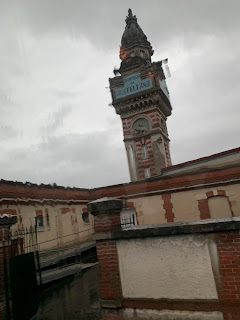Champagne
We drove into the Champagne area for two different but enjoyable tour/tastings. Sara gave us some facts and quotes on the way, including that there are 14,000 producers in the region, each owning an average of 2 hectares. Property is valued at 1 million euros per hectare. They use only 3 grapes - Chardonnay, Pinot Noir and Pinot Meunier. The Champagne region was formerly the northern most latitude to grow the grapes to produce champagne, but with climate change, other areas have been starting to produce similar sparkling wines, including Southern England. However, they are not allowed to call their wines champagne unless they are produced in that region.
We first stopped at Mercier, a large producer who produces between 1.1 million and 1.4 million bottles per year. They had a modern reception area with a huge decorated oak barrel in the center. We received an audio guide, like a little cell phone, with the commentary in English. We saw a movie about the entrepreneurial founder, who had the idea to produce champagne that everyone could afford. He started with a small co-op of growers and ended up buying them all out and now they have many hectares of their own as well as buying grapes from other producers. After an elevator ride down 30 meters, we boarded a little train and were driven through the caves that were carved out of the limestone to make and age the champagne. Maria had explained that the area was formerly an ancient riverbed, evidenced by lots of shell fossils, and this gives the wine a great mineral aspect. It also made it easy to carve the miles of cellars, including many cool wall carvings.
As we rode, the commentary described how they make the champagne, which includes two separate fermentations - the second one adds the bubbles. They age the bottles with a temporary cap in the cool, dark cellars, and rotate them on a machine to collect the sediment in the neck. Then they freeze the neck and the sediment pops out. They add some sugar and reserve wine and then seal them with the permanent cork and wire. After a couple months, they are ready to sell.
After the train ride, we went for a tasting of two of their champagnes: a Brut (which means less sweet) and a Blanc de Noir, which had some Pinot Noir grapes with the Chardonnay. The bartender/guide explained that the indentation in the bottom of the bottle is to strengthen it against all the pressure of the wine in the bottle. If they didn’t have the indentation, the bottle would have to have a very thick bottom. Sue and Julie liked the Blanc de Noir best, and Mary liked the Brut. We bought a bottle of each to take back to the hotel; they cost about $30 each. As we left Mercier, it started to rain hard. It is the first real rainy day we have had.
Two friends of Maria’s now joined us on the bus. Alain Boutillat owns a 6.5 hectare property producing 180,000 bottles per year and has now turned the operation over to his daughter, Valerie. Alain and Valerie were our tour guides through the lovely countryside, although they spoke no English, so Maria translated everything they said. We drove by many famous champagne properties in and around Epernay, the capital of the region. We also drove by a college where they train champagne producers and later met Valerie’s daughter, Matilde, who has just begun her studies. Apparently people come from all over the world to learn the craft.
At Moët & Chandon, we saw the statue of Dom Perignon, the monk credited with discovering how the fizz developed in champagne in 1375. It was actually a fluke that he created gas in a bottle of still wine, and then he spent years perfecting the method. The cork and wire seal he created is still used today. Moët & Chandon now owns over 800 hectares.
There were back to back to back champagne producers on our route. Each has to follow strict rules including picking the grapes by hand. Most of the harvesting was done last week, though we saw a few stragglers. The vines are planted to maximize their exposure. They are meticulously pruned. They do biodynamic treatments near towns and organic treatments further away, so as not to expose the people to the fumes. We passed many villages that were simply houses, vineyards, and maybe a church. Valerie explained they don’t have any shops in the villages - they all go to Epernay for the bakery, butcher, etc.
We arrived at the Alain Boutillat winery and went into a building where he explained the crushing machine. Then we climbed down some stairs into the cool cellar and saw the special stainless steel tanks where the crushed fruit ages about 8 months. This is the first fermentation where the sugar is converted to alcohol. At the end of the first fermentation, they take out the sediment so they don’t have as much to take out later.

















Comments
Post a Comment